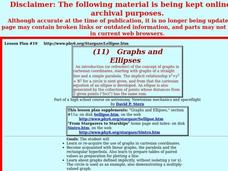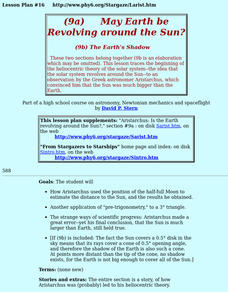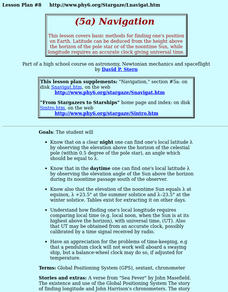Curated OER
The Angle of the Sun's Rays
Students study elevation of the Sun above the horizon and the angle of the rays and their heating power.
Curated OER
Motion in a Circle
Learners explore uniform circular motion, and the relation of its frequency of N revolutions/sec with the peripheral velocity v and with the rotation period T. They examine how uniform circular motion is a type of accelerated motion.
Curated OER
Graphs and Ellipses
Students explore linear graphs, the parabola and the rectangular hyperbola.
Curated OER
May The Earth Be Revolving Around The Sun?
Students trace the beginning of the heliocentric theory of the solar system--the idea that the solar system revolves around the Sun--to an observation by the Greek astronomer Aristarchus, which convinced him that the Sun was much bigger...
Curated OER
How Distant is the Moon?--2
Pupils examine total eclipses of the Sun and their limited regions of totality. They explain that this limited view occurs because the Moon is close enough to us for different points on Earth to view it differently.
Curated OER
Parallax
High schoolers discover how astronomers used the diameter of the Earth's orbit around the Sun as a baseline for estimating the distance of some stars, and the meaning of "Parsec" and "light year."
Curated OER
Precession
Students explain how Hipparchus, around 130 BC, used a shift in the predicted location of a lunar eclipse to detect a slight shift in the path of the Sun around the sky. They examine the elliptical orbit in which the Earth travels around...
Curated OER
Navigation
Young scholars study the basic methods for finding one's position on Earth. Latitude can be deduced from the height above the horizon of the pole star or of the noontime Sun, while longitude requires an accurate clock giving universal time.
Curated OER
Finding the Pole Star
Students study the constellations fo the Big Dipper and Cassiopeia and their use in finding the Pole Star. They realize that other celestial objects--Sun, Moon and planets--share the rotation (and hence rise and set), even though their...
Curated OER
May Earth be Revolving around the Sun?
Ninth graders explore how Aristarchus used the position of the half-full Moon to estimate the distance to the Sun, and how he made a great error, but still figured out that the Sun is much larger than Earth.
Curated OER
Rocketry
Students design and construct a paper rocket that can be launched with a drinking straw. They participate in a lecture and read an article about rocketry and how Newton's Third Law applies to rocket launches. Each student constructs...
Curated OER
Tasty Constellations
Pupils conduct research on a constellation and create a model of it using marshmallows as stars. They draw the constellation in pencil on black paper, glue on marshmallows, and trace the pencil with chalk to connect the stars.
Curated OER
Twinkle, Twinkle, Little Star
Young scholars identify patterns in the stars. In this constellation lesson plan, students simulate constellations using black canisters and patterns. Young scholars discuss the points on the constellations and how to draw imaginary...
Curated OER
PRIMARY AND SECONDARY SUCCESSION IN AMERICA'S FORESTS
Students examine forest organisms, features of some of the different types of forest, classify organisms based on the type of forest they come from, and explore how certain species are connected with other, particular species within...
Curated OER
Meteor Showers
Students use the Internet to discover the wonderful world of comets and meteor showers. They discover how to spot one and predict them using a calendar. They also examine the makeup of meteoroids and meteorites.
Curated OER
Stars and Constellations
Ninth graders investigate how ancient cultures viewed their world in terms of astronomy. They read and discuss an informational handout, construct an astrolabe, and locate stars and constellations using star charts.
Curated OER
Sunlight and the Earth # T
Young scholars learn that convection of heat in the atmosphere is the cause of weather phenomena. They learn that water vapor also carries solar heat and plays an important role in atmospheric convection.
Curated OER
The Sky Above Us
Young scholars examine the rotation of stars in the sky. They identify the pole star and what is different about this star compared to the others. They discuss how other objects in the sky have the same rotation.
Curated OER
Star Frames
Fourth graders study constellations. In this space science instructional activity, 4th graders discover what makes stars, how bright stars are, and why constellations were created. Students make their own constellation using Saran Wrap...
Curated OER
Exploring the Night Sky: Fall/Winter
Students explain how moon phases occur. They explain three ways that the night sky has been used through history. Students locate some of the constellations in the night sky. They discuss stories and myths surrounding stars.





















